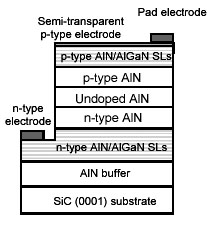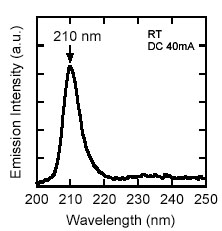Materials Science Laboratory
Aluminum nitride (AlN) is a direct-bandgap semiconductor with a bandgap
energy of 6 eV, the largest among semiconductors, and is therefore promising
for light-emitting devices with the shortest wavelength for semiconductors.
Recently, we have succeeded in p-type and n-type doping of AlN and have
fabricated a p-n homojunction AlN light-emitting diode (LED) [1].
The AlN layers were epitaxially grown on SiC (0001) substrate by metalorganic
vapor phase epitaxy (MOVPE). To improve the crystal quality of the
AlN layers, we suppressed the parasitic reaction of Al and N sources in
the gas phase. P-type and n-type AlN layers were obtained by Mg and
Si doping during MOVPE growth, respectively [1, 2]. Figure 1 shows
schematics of the AlN LED. In this LED structure, between the p-type
and n-type AlN layers, an undoped AlN emission layer was inserted to suppress
Mg- and Si-impurity-related emission from the p-type and n-type AlN layers.
The p-type and n-type AlN/AlGaN superlattices (SLs) were used to reduce
the contact resistance of the electrodes.
Figure 2 shows the emission spectrum of the AlN LED. Deep-ultraviolet
light emission was observed at 210 nm, the shortest wavelength ever reported
for any kind of semiconductors. On the basis of optical reflection
and cathodoluminescence measurements of free-exciton transition in AlN,
we assigned the light emission to a near-band-edge emission from AlN.
Because light with a shorter wavelength has a higher energy, the AlN
LEDs can be applied to light sources for decomposing very stable, harmful
chemical substances, such as dioxin and polychlorinated biphenyls (PCBs),
which cause serious environmental problems all over the world. We
will increase the emission efficiency of the AlN LEDs to a practical level
by further improving their crystal quality and doping efficiency.
[1] Y. Taniyasu, M. Kasu, and
T. Makimoto, Nature 441 (2006) 325.
[2] Y. Taniyasu, M. Kasu, and
T. Makimoto, Appl. Phys. Lett. 89 (2006) 182112.
 |
 |
||||
|
|